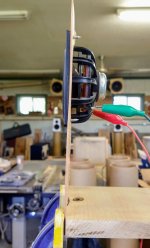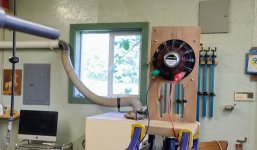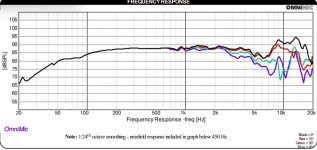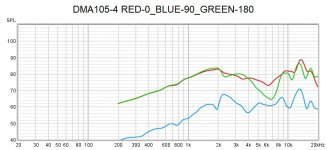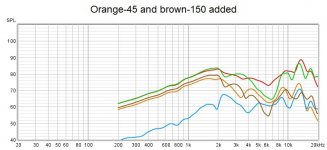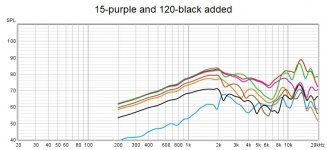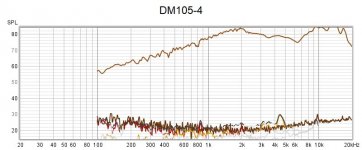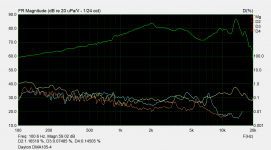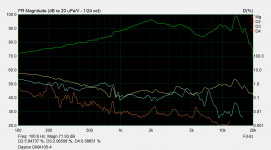Had about an hour before work today and was curious about the polars on this driver, so I dug one out and did a quick 0-180 on a small, thin piece of flat baffle. I had experimented with it some time back on this baffle, crossed to a GRS 3.5" planar on the top end at 1800hz, and a Satori W024P-4 9.5" at 500hz on the low end, forget the slopes. It sounded excellent, but life got in the way and I had to take it apart and put it away to clear space and work on something more urgent before I got any measurements.
Turns out it is a very good driver for the 500hz to 1800hz range on a minimal open baffle, and I imagine nude. I've included the published specs for the driver also. It's a 5ms window with the sweep starting at 100hz with 6db/oct smoothing. Not sure exact distance, but less than a meter. I was in a hurry, I'll do better ones at a later date, but this showed me what I wanted to know.
Turns out it is a very good driver for the 500hz to 1800hz range on a minimal open baffle, and I imagine nude. I've included the published specs for the driver also. It's a 5ms window with the sweep starting at 100hz with 6db/oct smoothing. Not sure exact distance, but less than a meter. I was in a hurry, I'll do better ones at a later date, but this showed me what I wanted to know.
Attachments
Last edited:
I investigated this driver myself, albeit nude, about 18 months ago. It's not bad, and you are correct that the FR can work well in the 500-2500 Hz range when nude. The problem I found was that output capability was pretty low, and distortion quickly climbs below 900 Hz as soon as the SPL level is increased a bit. This was without any FR compensation or flattening, which I interpreted to mean that when flattened out, the distortion would not be acceptable below 900Hz or so. Only using the driver above there did not make much sense for my application so I just put them on the shelf (literally). Also IIRC max power is not very high, which limits how much you can boost/flatten the low end and max SPL potential. But it is an interesting driver for sure and is very affordable.
Appreciate that Charlie. It seems using the stronger 8 ohm motor in an MTM configuration may be the most appropriate application in that case. The open square frame and small magnet are excellent for a nude dipole, as well as the price for sure.
Did you happen to check out the 8 ohm version too? If not I may grab some and investigate further.
Did you happen to check out the 8 ohm version too? If not I may grab some and investigate further.
It was the 4 Ohm version that I tested.
Using two of the 8 Ohm in parallel will improve sensitivity and will have twice the radiating area. It's worth a try.
This driver would be nice if lower SPLs are OK, for example in a nearfield application, although that is not typical of OB speakers. Maybe as part of low-cost a desktop OB?
Using two of the 8 Ohm in parallel will improve sensitivity and will have twice the radiating area. It's worth a try.
This driver would be nice if lower SPLs are OK, for example in a nearfield application, although that is not typical of OB speakers. Maybe as part of low-cost a desktop OB?
This is the distortion from the on axis measurement yesterday. I'll take some better ones this morning, the noise floor appears high.
Yes, that's along the lines I was thinking. An MTM crossed at 600hz may ameliorate the distortion and output issues.
Yes, that's along the lines I was thinking. An MTM crossed at 600hz may ameliorate the distortion and output issues.
Attachments
A single nude driver should be capable of around 109db at 560hz at x-max, and get another 6db from the woofer at the crossover. Add another 6db for the second driver if MTM. I usually shoot for 110db output capability at x-max.
Often Xmax = 10% distortion threshold. I would adopt a more conservative approach like 1% distortion. You have to measure it, since also soft part linearities will contribute to distortion overall.
I am attaching my distortion measurements of the driver. First one at low level, and next at higher SPL. I don't recall what those were, exactly, and the SPL level shown is not accurate.
Drivers reach 1% all the time, so this is not all that terrible. I just had some better options at my disposal.
I am attaching my distortion measurements of the driver. First one at low level, and next at higher SPL. I don't recall what those were, exactly, and the SPL level shown is not accurate.
Drivers reach 1% all the time, so this is not all that terrible. I just had some better options at my disposal.
Attachments
I also shoot for 40db down or 1% distortion as 'on the verge' of being able to hear it. In my experience a low pass filter significantly reduces the distortion 1/2 to 1 octave above it, depending on what's causing it.
- Home
- Loudspeakers
- Multi-Way
- DMA105-4 polar FR measurements minimal baffle
